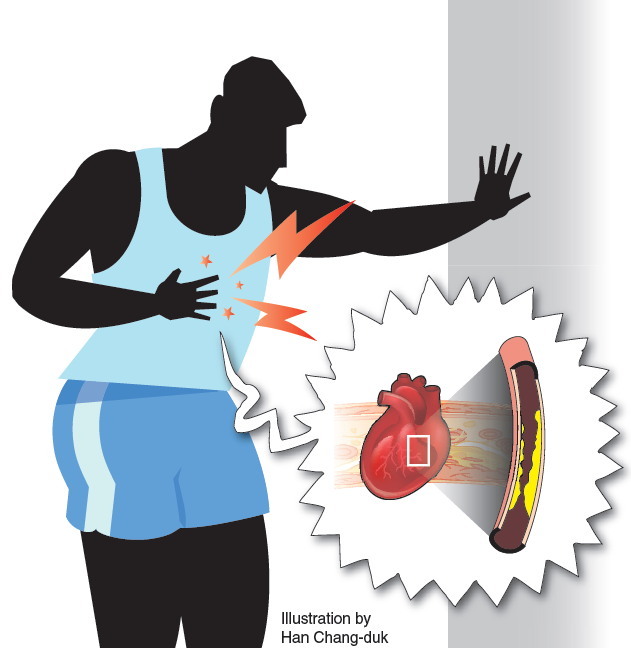Chest pain refers to various pains in the chest, which can be due to a wide range of causes. Chest pain or discomfort in the chest is a relatively common condition found in 1-2 percent of all patients, and 1.9 percent of all emergency presentations. Its causes vary widely and the clinical significance and progress differs for each cause. Therefore chest pain should be diagnosed carefully. The main causes of chest pain include problems in the lungs, heart, esophagus or ribs. Of these causes, chest pain due to cardiac causes only account for 1-2 in every 10 patients.
Angina is chest pain due to cardiac causes. Angina presents as a tight pain across the chest, particularly in the front (sternum), below or to the left of the heart. The pain is severe, and is associated with a sensation of impending doom. It tends to last from several minutes up to 10 minutes, and can radiate to the neck, chin or inside the arms. Angina is often associated with rapid walking, climbing up stairs or a hill, heavy lifting, psychological anxiety or agitation, and tends to settle with rest. It can also be associated with sudden exposure to the cold, or exercising too soon after eating. Some patients (approximately 15 percent) complain of indigestion, heartburn, fatigue, sweating, vomiting or breathlessness, which tends to occur with exercise. If you feel chest pain, you should stop exercising or doing the work you are doing, and rest. If you have the following symptoms of angina, you should see your doctor for a check-up.
Pain associated with activity or exercise
● You generally do not need to worry about chest pain that arises when you are exercising and improves with rest.
Pain across the chest that occurs below the sternum and feels as a tightness/ heaviness/ pressure
● Pain that is localized, that can be pinpointed with 1-2 fingers and is sharp in nature, is unlikely to be angina.
Pain that spreads to the neck, chin, arms or teeth
● These pains often follow from chest pain. Such pains without chest pain are unlikely to have a cardiac cause.
Chest pain that lasts 5-10 minutes and settles with rest
● The duration of pain is often associated with the severity of the condition. Chest pain that lasts beyond 20 minutes even with rest can be progressive myocardial infarction (heart attack) so you should seek medical attention immediately. However, any pain that lasts for hours or all day is unlikely to be cardiac in nature.
Repeated episodes of indigestion, heartburn, fatigue, sweating or vomiting with exercise
● Not all patients with angina have chest pain, so if you experience the above symptoms with exercise you should see a doctor for further tests.
Another main cause of chest pain is problems with the esophagus. Chest pain due to esophagus motility problems can present similarly to angina. Gastroesophageal reflux disease (GERD) often occurs when you wake up in the morning, and feel a burning pain in the center of the chest (location of the esophagus). Chest pain can also be caused by pneumonitis or pneumonia, and can sometimes be associated with pneumothorax, pulmonary embolism, aortic dissection, herpes zoster or mechanical trauma to the chest.
Cardiac chest pain generally occurs in the left side of the chest. Right-sided chest pain is likely to be due to the ribs or the lungs. If you have lots of phlegm production, the pain may be due to problems with the lungs or bronchi. If there was a severe cough, there may have been a fracture of the ribs due to ongoing coughing. Pain from pneumonitis can feel like an ache when you breathe in and out deeply. It can also present as an achy pain when moving the upper body.
A pressure-like pain in the joint between the sternum and the cartilage is known as Teitz’s syndrome. This generally settles with simple analgesics. Pain when pressing on the ribs around the right lower chest can be due to rib fractures, which can be confirmed with radiological imaging. Sometimes, a healthy young person may present with chest pain with unclear causes. In some cases, a patient can present with atypical chest pain, which is not associated with cardiac problems, but more functional. Functional pain often feels like a sharp pain, different to that of typical angina, when the patient is resting. It is not associated with a specific cause, and its onset is sudden. It does not radiate to other parts of the body and is often sharp in nature. This type of pain generally does not need further treatment.
Cardiac chest pain generally comes on with activity, and goes away with rest. Angina is often associated with rapid walking, climbing up stairs or a hill, heavy lifting, psychological anxiety or agitation, and tends to settle with rest. It can also be caused by exposure to the cold, or exercising immediately after eating. Chest pain that arises when you are resting, or pain that is localized to a small area (for example, can be pinpointed with 1-2 fingers), sharp-like, or burning pain is unlikely to be angina.
 |
| Song Young-bin |
By Song Young-bin
Song Young-bin is a doctor at the Division of Cardiology of Samsung Medical Center and professor at Sungkyunkwan University’s School of Medicine. ― Ed



